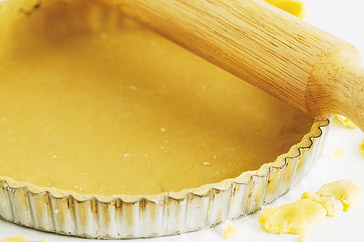|
Shortcrust Pastry
Ingredients:This Shortcrust Pastry recipe will make enough to line a 23cm tin or a 9" tart dish. 1 1/2 cups plain flour 100g chopped chilled unsalted cutter 2 - 4 tablespoons chilled water 2 tablespoons of caster sugar (optional) Method:Sift the flour into a large bowl and add the butter. Using just your fingertips, rub the butter into the flour until the mixture resembles fine breadcrumbs. Make a well in the centre, then add 2-4 tablespoons water and mix with a flat-bladed knife. Use a cutting rather than a stirring action and turn the bowl with your free hand. The mixture will come together in small beads of dough. To test if you need more water, pinch a little dough between your fingers. If it doesn't hold together, add a little more water. If the pastry is too dry, it will fall apart when you roll it; if too wet it will be sticky and shrink when baked. Gently gather the dough together with your hand and lift out onto a sheet of baking paper or a floured work surface. Press, don't knead, the dough together into a ball. Handle gently, keeping your actions light and to a minimum. Press the dough into a flat disc, wrap and refrigerate for 20 minutes. Roll out between 2 sheets of baking paper or plastic wrap, or on a lightly floured surface. Always roll from the centre outwards, rotating the dough, rather than rolling backwards and forwards. If you used baking paper to roll out the pastry, remove the top sheet, carefully invert the pastry over the tin or tart dish (make sure you centre the pastry, as it can't be moved once in place), and then peel away the paper. If you rolled out on a lightly floured surface, roll the pastry back over the rolling pin so it is hanging, and ease it into the tin/dish. Once the pastry is in the tin, quickly lift up the sides so they don't break over the edges of the tin, which can be sharp, particularly in metal flan tins. Use a small ball of excess dough to help ease and press the pastry shell into the side of the tin. Allow the excess to hang over the side and, if using a flan tin, roll the rolling pin over the top of thetin, to cut off the excess pastry. If you are using a glass or ceramic pie dish, use a small sharp knife to cut away the excess pastry. However gently you handle dough, it is bound to shrink a little, so let it sit a little above the sides of the tin. If you rolled off the excess pastry with a rolling pin, you may find it has "bunched" down the sides. Gently press the sides of the pastry with your thumbs to flatten and lift it a little. Refrigerate the pastry in the tin for 15 minutes to relax it and prevent or minimise shrinkage. Preheat the oven. Blind Baking:If pastry is to have a moist filling, it will probably require partial blind baking to prevent the base becoming soggy. If it is not cooked again after filling, it will need to be fully blind baked. This means baking the pastry without the filling, but with some weight to prevent it rising. Line the shell with crumpled greaseproof or baking paper. Pour in some baking beads, dried beans or uncooked rice (these can be used again). Bake the pastry for the given time, then lift out the filled paper. Return the pastry to the oven. When cooked, it should look dry with no greasy patches. Small pastry shells can just be pricked with a fork to prevent them rising or bubbling, but only do this if specified, as the filling may run through. Cool pastry completely before filling. Cooked filling should also be cooled before adding, to prevent soggy pastry.
To Lemon Meringue Pie from Shortcrust Pastry
|

